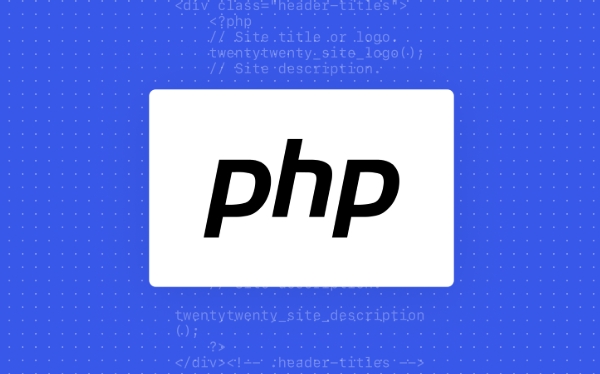A PHP server is an environment where a web server and a PHP interpreter combine to run PHP code. It handles user requests, executes PHP scripts and returns the results to the browser. Common configurations include Apache mod_php, Nginx PHP-FPM and one-click packages for development environments such as XAMPP/WAMP/MAMP. The running process is: 1. The browser sends a request; 2. The web server recognizes the PHP file; 3. Returns to the PHP interpreter for processing; 4. PHP executes the script and outputs HTML; 5. The server returns the content to the browser. When configuring, you need to pay attention to php.ini settings, permission management, fastcgi_pass correctness and enable error prompts for debugging.

A PHP server is actually an environment that can run PHP code, which usually works with a web server. Its core role is to process user requests, execute PHP scripts, and return the results to the browser. If you have used WordPress or have written a simple PHP page yourself, you have already dealt with the PHP server.

The following sections will explain how it works, common configuration methods, and some things to pay attention to.
What is a PHP server?
Strictly speaking, PHP itself is not a "server", but a scripting language embedded in HTML. What really works is a combination of web servers (such as Apache or Nginx) working with PHP interpreter.

When you access a .php file, the web server will hand over the file to the PHP engine for processing. After processing, generate HTML content and return it to the browser through the server. This is why you can see dynamic content on the page, such as time, login status, or database query results.
To give the simplest example: you enter example.com/index.php in the browser. After receiving this request, the server first determines that this is a PHP file. Then, call the PHP module to parse the code inside, and return the final HTML to the browser after the execution is completed.

Common PHP server environment configuration
There are many ways to build a PHP server, and the common ones are as follows:
Apache mod_php
This is the most classic combination. Apache is a web server, mod_php is Apache's module, which is responsible for directly parsing PHP files. The advantage is that the configuration is simple and suitable for beginners.Nginx PHP-FPM
Many high-performance websites now use this combination. Nginx handles static resources quickly, and PHP-FPM (FastCGI Process Manager) specializes in processing PHP requests, which is more efficient and easier to load balancing.One-click package for development environment (XAMPP/WAMP/MAMP)
If you just want to test PHP programs locally, these tools can quickly start Apache and PHP environments, saving you the hassle of manual configuration.
It is important to choose different combinations in different scenarios. For example, if you do small projects or study, XAMPP is enough; but it is recommended to use Nginx PHP-FPM for online deployment, which has more stable performance.
Brief description of PHP server operation process
When a user accesses a PHP page, the entire process is roughly as follows:
- The browser sends HTTP request to the server
- The web server recognizes that the requested PHP file is
- Transfer the request to the PHP interpreter for processing
- PHP executes scripts, may connect to databases, read files, etc.
- Output HTML content to the web server
- The server returns the content to the browser to display
This process looks fast, but each link can affect performance. For example, slow database query and complex script logic will all lead to slow response.
Sometimes you will find that the page loads very slowly, but it is not a network problem. It may be that the server-side PHP script execution is not efficient and requires optimization of the code structure or adding cache.
Details to pay attention to when configuring a PHP server
There are several settings that are often ignored but can affect the program's running:
- The configuration items in the
php.inifile are very important, such as maximum upload limit (upload_max_filesize), execution time (max_execution_time), etc. - Permission issues are also critical, especially when uploading directories or log directories. Incorrect permissions may cause the program to fail to write files.
- If using Nginx, please note whether the fastcgi_pass setting is correct, otherwise a 502 error will appear
- Remember to enable error prompts (display_errors = On) during the development stage, for easy debugging
Sometimes when you have just deployed the server, you only see blank pages when you visit the PHP page. At this time, it is likely that the syntax error has been silently ignored. You can see the problem by opening the error prompt.
Basically that's it. PHP server sounds a bit abstract, but as long as you understand how it works with the web server, many problems can be solved.
The above is the detailed content of PHP Server Explained. For more information, please follow other related articles on the PHP Chinese website!

Hot AI Tools

Undress AI Tool
Undress images for free

Undresser.AI Undress
AI-powered app for creating realistic nude photos

AI Clothes Remover
Online AI tool for removing clothes from photos.

Clothoff.io
AI clothes remover

Video Face Swap
Swap faces in any video effortlessly with our completely free AI face swap tool!

Hot Article

Hot Tools

Notepad++7.3.1
Easy-to-use and free code editor

SublimeText3 Chinese version
Chinese version, very easy to use

Zend Studio 13.0.1
Powerful PHP integrated development environment

Dreamweaver CS6
Visual web development tools

SublimeText3 Mac version
God-level code editing software (SublimeText3)

Hot Topics
 Building Immutable Objects in PHP with Readonly Properties
Jul 30, 2025 am 05:40 AM
Building Immutable Objects in PHP with Readonly Properties
Jul 30, 2025 am 05:40 AM
ReadonlypropertiesinPHP8.2canonlybeassignedonceintheconstructororatdeclarationandcannotbemodifiedafterward,enforcingimmutabilityatthelanguagelevel.2.Toachievedeepimmutability,wrapmutabletypeslikearraysinArrayObjectorusecustomimmutablecollectionssucha
 Building RESTful APIs in Java with Jakarta EE
Jul 30, 2025 am 03:05 AM
Building RESTful APIs in Java with Jakarta EE
Jul 30, 2025 am 03:05 AM
SetupaMaven/GradleprojectwithJAX-RSdependencieslikeJersey;2.CreateaRESTresourceusingannotationssuchas@Pathand@GET;3.ConfiguretheapplicationviaApplicationsubclassorweb.xml;4.AddJacksonforJSONbindingbyincludingjersey-media-json-jackson;5.DeploytoaJakar
 A Developer's Guide to Maven for Java Project Management
Jul 30, 2025 am 02:41 AM
A Developer's Guide to Maven for Java Project Management
Jul 30, 2025 am 02:41 AM
Maven is a standard tool for Java project management and construction. The answer lies in the fact that it uses pom.xml to standardize project structure, dependency management, construction lifecycle automation and plug-in extensions; 1. Use pom.xml to define groupId, artifactId, version and dependencies; 2. Master core commands such as mvnclean, compile, test, package, install and deploy; 3. Use dependencyManagement and exclusions to manage dependency versions and conflicts; 4. Organize large applications through multi-module project structure and are managed uniformly by the parent POM; 5.
 css dark mode toggle example
Jul 30, 2025 am 05:28 AM
css dark mode toggle example
Jul 30, 2025 am 05:28 AM
First, use JavaScript to obtain the user system preferences and locally stored theme settings, and initialize the page theme; 1. The HTML structure contains a button to trigger topic switching; 2. CSS uses: root to define bright theme variables, .dark-mode class defines dark theme variables, and applies these variables through var(); 3. JavaScript detects prefers-color-scheme and reads localStorage to determine the initial theme; 4. Switch the dark-mode class on the html element when clicking the button, and saves the current state to localStorage; 5. All color changes are accompanied by 0.3 seconds transition animation to enhance the user
 python parse date string example
Jul 30, 2025 am 03:32 AM
python parse date string example
Jul 30, 2025 am 03:32 AM
Use datetime.strptime() to convert date strings into datetime object. 1. Basic usage: parse "2023-10-05" as datetime object through "%Y-%m-%d"; 2. Supports multiple formats such as "%m/%d/%Y" to parse American dates, "%d/%m/%Y" to parse British dates, "%b%d,%Y%I:%M%p" to parse time with AM/PM; 3. Use dateutil.parser.parse() to automatically infer unknown formats; 4. Use .d
 How to use Java MessageDigest for hashing (MD5, SHA-256)?
Jul 30, 2025 am 02:58 AM
How to use Java MessageDigest for hashing (MD5, SHA-256)?
Jul 30, 2025 am 02:58 AM
To generate hash values using Java, it can be implemented through the MessageDigest class. 1. Get an instance of the specified algorithm, such as MD5 or SHA-256; 2. Call the .update() method to pass in the data to be encrypted; 3. Call the .digest() method to obtain a hash byte array; 4. Convert the byte array into a hexadecimal string for reading; for inputs such as large files, read in chunks and call .update() multiple times; it is recommended to use SHA-256 instead of MD5 or SHA-1 to ensure security.
 css dropdown menu example
Jul 30, 2025 am 05:36 AM
css dropdown menu example
Jul 30, 2025 am 05:36 AM
Yes, a common CSS drop-down menu can be implemented through pure HTML and CSS without JavaScript. 1. Use nested ul and li to build a menu structure; 2. Use the:hover pseudo-class to control the display and hiding of pull-down content; 3. Set position:relative for parent li, and the submenu is positioned using position:absolute; 4. The submenu defaults to display:none, which becomes display:block when hovered; 5. Multi-level pull-down can be achieved through nesting, combined with transition, and add fade-in animations, and adapted to mobile terminals with media queries. The entire solution is simple and does not require JavaScript support, which is suitable for large
 VSCode settings.json location
Aug 01, 2025 am 06:12 AM
VSCode settings.json location
Aug 01, 2025 am 06:12 AM
The settings.json file is located in the user-level or workspace-level path and is used to customize VSCode settings. 1. User-level path: Windows is C:\Users\\AppData\Roaming\Code\User\settings.json, macOS is /Users//Library/ApplicationSupport/Code/User/settings.json, Linux is /home//.config/Code/User/settings.json; 2. Workspace-level path: .vscode/settings in the project root directory






